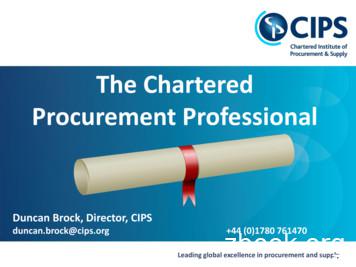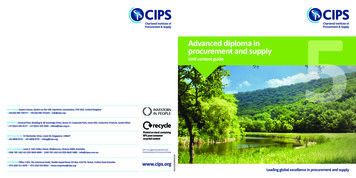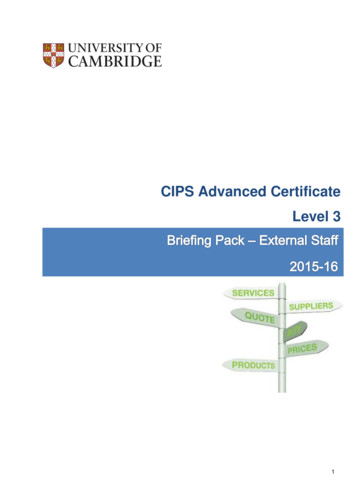Sustainable Procurement - CIPS
CIPS Procurement TopicSustainable ProcurementMost large organisations have adoptedsome aspects of good sustainableprocurement practices (CIPS: Sustainableprocurement).CIPS members can record one CPD hour for reading a CIPS Knowledge download that displays aCIPS CPD icon.Leading global excellence in procurement and supply
Sustainable Procurement - Procurement TopicIntroductionThe factors that should be considered by sustainable procurement include non-renewablematerial use, manufacture and production methods, logistics, recycling options, disposal andsupplier capabilities. At the macro level, sustainable procurement can deliver better economic,environmental and social outcomes. These macro level issues also need to be considered whileanalysing the impact of sustainable procurement on the purchasing and supply chainenvironment: economic impact of sustainability refers to corporate governance, ethical tradingand payment on time; environmental impact may include biodiversity, climate change andcarbon footprints factors; and social impact incorporates diversity and human rights (CIPS:Sustainable Procurement). At the micro/organisational level, sustainable procurement cangenerate value for money and raise efficiencies within organisations (e.g. by managing supplyrisks and augmenting resource productivity levels) and lead to cost effective procurement(CIPS: Sustainable procurement; Improvement and Development Agency, 2003; Thomson andJackson, 2007).Sustainability in an organisation can be captured across three levels: legal requirements, costand waste reduction and mitigation of risks, protection of brand and reputation (CIPS:Sustainable procurement). Organisations can also use sustainability initiatives to increaseemployee involvement and participation, and change certain practices embedded inorganisational culture (Boxall and Macky, 2009; Improvement and Development Agency, 2003;Thomson and Jackson, 2007; Vandenberg et al., 1999).Some organisations do not treat ideas of sustainable procurement with careful considerationand fail to comprehend the way sustainable procurement practices can modify or align withexisting procurement practices. Ideally, these should be integrated into an approach thatencourages lifecycle systems management (Monczka et al., 2009).Legislation increasingly acts as a driver for adopting culture and practices supportingsustainable procurement in organisations (CIPS: Sustainable procurement). Underpinning thiscore legislation are various regulations and directives, such as the Waste, Electrical andElectronic (WEEE) Directive, a Waste Framework Directive and the regulations governing theregistration, evaluation, authorisation and restriction of chemicals (REACH).DefinitionSustainable procurement as "a process whereby organisations meet their needs for goods,services, works and utilities in a way that achieves value for money on a whole life basis interms of generating benefits not only to the organisation, but also to society and the economy,whilst minimising damage to the environment" (Department for Environment, Food and RuralAffairs, 2006).Successful applicationImplementing sustainable procurement is not an easy task. At the same time, it is making animpact or at least starting the process achievable. Thus, sustainability can be incorporated intodifferent elements of the whole procurement process (e.g. defining needs, evaluating options,design and specifying, supplier selection, tender evaluation, post-contract management andsupplier development). For example, a company can consider energy efficient products, whichoften have an increased capital cost but which are offset by lower operating costs(Improvement and Development Agency, 2003).1
Sustainable Procurement - Procurement TopicSteps to successful application1. Adopt a sustainable procurement policy: establish the role of procurement professionalsand buyers, adopt the standards or targets showing what will and will not be bought andagree on the techniques to be used (e.g. whole life costing, risk assessment).2. Challenge current culture within the company.3. Publish the sustainable procurement policy as a clear commitment to action and ensurethat senior figures visibly pursue this policy and demonstrate their commitment to realaction and change.4. Develop a dialogue with suppliers: discuss with suppliers the possibility of a moresustainable version of current purchases (e.g. furniture with a higher recycled content). Fornew procurements, include sustainability in the basic specification.Improvement and Development Agency (2003); Senge (2010)Hints and tipsSenior management must understand the true business case for sustainable procurement. Itmight be difficult to achieve buy-in from lower level employees if the people at the top are notserious about sustainability (Hughes and Day, 2011).Central to making sustainable procurement work is motivating suppliers to offer moresustainable products. Buyers and users should start to define functional performancespecifications (including sustainability), rather than just the technical specifications of knownproducts (Improvement and Development Agency, 2003).It is important to give suppliers advance warning about any changes in the product andcomponent requirements if these are caused by new organisational sustainable procurementpractices (Improvement and Development Agency, 2003).Implementing sustainable procurement practices will require extensive discussions with majorstakeholders identified along the supply chain, for example customers, suppliers, managers,employees, government, banking and financial institutions, shareholders (Burnes, 2009).Potential advantagesSustainable procurement approaches can demonstrate P&SM;’s value to the organisationand raise corporate image in the market (Lysons and Farrington, 2006).Sustainable procurement can reduce waste and improve resource efficiency, ensuring thatcosts are minimised and processes are more efficient (Thomson and Jackson, 2007).Sustainable procurement is associated with lower degrees of business risk under certaincircumstances (Thomson and Jackson, 2007).Potential disadvantagesAchieving sustainable procurement can be difficult for companies that do not adopt alifecycle systems approach which can maximise value, transparency and sustainability andreduce costs and risks at every stage of the value chain (Supply Management, 2008).There is a risk that sustainable procurement may be perceived as an option for larger organisations who have the necessary financial, human and other resources to invest in sustainable practices (Adams and McNicholas, 2007).Additional time and resources need to be continuously invested in aligning internal sustainable procurement practices and those of suppliers with changing legislative requirements.2
Sustainable Procurement - Procurement TopicThis is particularly critical for organisations operating large and complex supply chainsspanning various countries where legislation and de facto working practices vary to thehome country of business (Department for Environment, Food and Rural Affairs, 2006; Improvement and Development Agency, 2003).Performance monitoringBenchmarking: comparing company practices (e.g. ethical sourcing, or corporate social responsibility) with best-in-class performance (Hughes and Day, 2011).Perceptions of those external to the organisation (Hughes and Day, 2011).Business alignment and stakeholder engagement: need to be measured to achieve a clearlinkage between business strategy, goals and sustainable procurement initiatives (Hughesand Day, 2011).Case studiesPremier Farnell, a global electronics distributer with an annual turnover of 833m, workedclosely with NGO Action Sustainability to develop sustainable procurement policies for itshuge supply network. Action Sustainability convinced the company of the many businessopportunities to be seized (e.g. first mover advantage and the chance to build new commercial relationships). Procurement is now central to delivering the company’s ambitions(CIPS: Managing the Storm and Beyond).The sustainable food procurement in the east of England, aimed at enabling Local Education Authorities (LEAs) caterers to source more sustainable produce for schools meals locally, helped LEAs creating new supply chains for regional meat and defining new contractclauses. The project helped participants achieve a 150,000 increase in meat for schooldinners sourced in the region and bought locally and a likelihood of a further 600,000worth of local meat going into hospital food (Sustainable Procurement Information Network: Sustainable food procurement in the East of England).In 2006 the Gateshead Council won the Energy Saving Trust’s ‘Fleet Hero Award’ as thetransport department's recognition of the Council's drive towards sustainable development. The Council was rewarded for introducing 20% bio-fuel to a tenth of all their vehicles,for training drivers in fuel efficiency and for allocating them jobs closer to their homes,which in combination led to 77,000 savings in the first year (Sustainable Procurement Information Network: Gateshead Council introduce Bio-diesel).Further Resources/ReadingWebThe Environment Agency - Sustainable procurementCommission for a Sustainable London 2012.West Midlands: SME and sustainable procurement.Industry Council for Packaging and the Environment.Non-profit organisation promoting sustainable procurement.3
Sustainable Procurement - Procurement TopicBooksSustainable Supply Chain Management: Practical Ideas for Moving Towards Best Practice ISBN978-3642120220Purchasing and Supply Chain Management ISBN 978-0273694380Sustainable Strategic Management ISBN 978-0765611314Purchasing and Supply Chain Management: Analysis, Strategy, Planning and Practice ISBN 9781408018965Principles of Supply Chain Management: A Balanced Approach ISBN 978-0324657913ReferencesAdams, C.A. and McNicholas, P. (2007) Making a Difference: Sustainability Reporting,Accountability and Organisational Change, Accounting. Auditing and Accountability Journal,Vol. 20(3), pp. 382-402.Bhattacharya, C.B. and Sen, S. (2004) Doing Better at Doing Good: When, Why, and HowConsumers Respond to Corporate Social Initiatives. California Management Review, Vol. 47(1),pp. 9-24.Burnes, B. (2009) Managing Change (5th ed.) Pearson Education: Essex, UK.Butner, K. (2007) Blueprint for Supply Chain Visibility. Institute for Business Value. IBM GlobalBusiness Services: New York.CIPS: Managing the Storm and Beyond.CIPS: Sustainable Procurement.Department for Environment, Food and Rural Affairs (2006) Procuring the Future: SustainableProcurement National Action Plan: Recommendations from the Sustainable Procurement TaskForce. Department for Environment: Food and Rural Affairs, London.Hughes, J. and Day, M. (2011) Benchmarking Performance Against Ten Value Levers.DILForientering, Vol. 48, pp. 6-11, April.Improvement and Development Agency (2003) Sustainable Procurement: Making It Happen.London.Lysons, K. and Farrington, B. (2006) Purchasing and Supply Chain Management. PearsonEducation: Essex, UK.Monczka, R.M., Handfield, R.B., Giunipero, L.C. and Patterson, J.L. (2009) Purchasing andSupply Chain Management. South-Western Cengage Learning: Mason, OH.Reinhardt, F. (2004) Nestle: Sustainable Agriculture Initiative. Havard Business School: Boston,MA.Senge, P. (2010) The Sustainable Supply Chain. Harvard Business Review, October.4
Sustainable Procurement - Procurement TopicSupply Management (2007) Buyers Must Consider Long-term Effects. [online] Available consider-long-termeffects/?locale en [Accessed 20 December 2011].Supply Management (2008) Build a Greener Future. [online] Available ner-future/?locale en[Accessed 20 December 2011].Sustainable Procurement Information Network: Gateshead Council Introduce Bio-diesel.[online] Available at: www.s-p-i-n.co.uk/casestudies.asp [Accessed 20 December 2011].Sustainable Procurement Information Network. Sustainable Food Procurement in the East ofEngland. [online]Available at: www.s-p-i-n.co.uk/casestudies.asp [Accessed 20 December 2011].Thomson, J. and Jackson, T. (2007) Sustainable Procurement in Practice: Lessons From LocalGovernment. Journal of Environmental Planning and Management, Vol. 50(3), pp. 421-44.Vandenberg, R.J., Richardson, H.A. and Eastman, L.J. (1999) The Impact of High InvolvementWork Processes on Organisational Effectiveness: A Second-order Latent Variable Approach.Group and Organisation Management, Vol. 24(3), pp. 300-339.VideoSustainable procurement metricshttps://www.youtube.com/watch?v 1TFkAm852Jg5
Sustainable Procurement - Procurement Topic6
CIPS Procurement Topic Sustainable Procurement . At the macro level, sustainable procurement can deliver better economic, environmental and social outcomes. These macro level issues also need to be considered while . 4 Books Sustainable Supply Chain Management: Practical I
Leading global excellence in procurement and supply 1 The Chartered Procurement Professional Duncan Brock, Director, CIPS duncan.brock@cips.org 44 (0)1780 761470 . Leading global excellence in procurement and supply 2 Introducing CIPS Chartered Body Charitable Status Awarding Body Membership Organisation CIPS for Business . Leading global .
CIPS Asia PacificIG Rochester Drive, Level HJ, Singapore, GINLIM TPLK LNFN NMHG FPLK LNFN NMHH Einfosg@cips.org CIPS AustralasiaLevel H, KHF Collins Street, Melbourne, Victoria IFFF, Australia TGIFF MLK GJH/PLG (F)I OLHO LFFF FGIFF MLK GJI/PLG (F)I OLHF KJNN Einfo@cipsa.com.au CIPS MENAOffice GMFI, The Fairmont Hotel, Sheikh Zayed Road, PO Box GGOMMJ, Dubai, United Arab Emirates TPOMG (F)J IGG .
CIPS Level 5 5 Advanced Diploma in Procurement and Supply Ref: 603/3925/1 6\OODEXV Version 1 Fhyzics Business Consultants Pvt. Ltd. An Approved Study Centre of CIPS, UK www.IISCM.org cs@fhyzics.net 91 900-304-9000. Your TXDOLIÂFDWLRQ Next steps 7KLV TXDOL 4FDWLRQ SURYLGHV SURJUHVVLRQ WR WKH CIPS Level 6 Professional Diploma in Procurement and Supply. 5HIHUV WR OHYHOV ZLWKLQ WKH 8. 54 .
The University CIPS Level 3 Programme 2.1. About the CIPS Programme The University’s CIPS Level 3, Advanced Certificate in Procurement and Supply Operations programme is partly funded through the Finance Division. You may apply if you work in one of the University colleges, the University Press or Cambridge Assessment or other associated institution, although funding will be requested from .
It is designed as a follow on from the CIPS Level 2 Certificate in Procurement and Supply Operations as learners are expected to develop, use and apply the professional language and skill sets introduced at Level 2 within a practical working environment. Individuals will be working at the Tactical but moving towards the Operational level of the CIPS Global Standard for Procurement and Supply .
CIPS Level 3 Advanced Certificate in Procurement and Supply Operations is designed for individuals who will be working at the Tactical but moving towards the Operational level of the CIPS Global Standard for Procurement and Supply. This is the first level of
CIPS Exam Fee 3 3 4 0 5 3 1 CIPS Membership Fee 3 3 4 0 5 3 2 Where to make the Payment . Category management in procurement and supply 3 hours Professional diploma in procurement and supply PD4 Supply chain dili
ARCHAEOLOGICAL ILLUSTRATION 8 IMAGE GALLERY - SCRAN images to draw IMAGE GALLERY - illustrations from the 19 th century to the present day IMAGE GALLERY - illustrations from 19th century to the present day STONE WORK Stones with incised crosses, St N inian’s Cave, Wigtownshire. Illustration from Proceedings of the Society of Antiquaries of Scotland (1884-85), Figs. 2 and 3, p84 .






















